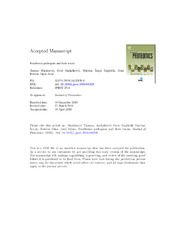Приказ основних података о документу
Foodborne pathogens and their toxins
| dc.creator | Martinović, Tamara | |
| dc.creator | Anđelković, Uroš | |
| dc.creator | Srajer-Gajdošik, Martina | |
| dc.creator | Rešetar, Dina | |
| dc.creator | Josić, Djuro | |
| dc.date.accessioned | 2023-11-28T16:35:31Z | |
| dc.date.available | 2017-04-22 | |
| dc.date.issued | 2016 | |
| dc.identifier.issn | 1874-3919 | |
| dc.identifier.uri | https://cer.ihtm.bg.ac.rs/handle/123456789/6915 | |
| dc.description.abstract | Foodborne pathogens, mostly bacteria and fungi, but also some viruses, prions and protozoa, contaminate food during production and processing, but also during storage and transport before consuming. During their growth these microorganisms can secrete different components, including toxins, into the extracellular environment. Other harmful substances can be also liberated and can contaminate food after disintegration of food pathogens. Some bacterial and fungal toxins can be resistant to inactivation, and can survive harsh treatment during food processing. Many of these molecules are involved in cellular processes and can indicate different mechanisms of pathogenesis of foodborne organisms. More knowledge about food contaminants can also help understand their inactivation. In the present review the use of proteomics, peptidomics and metabolomics, in addition to other foodomic methods for the detection of foodborne pathogenic fungi and bacteria, is overviewed. Furthermore, it is discussed how these techniques can be used for discovering biomarkers for pathogenicity of foodborne pathogens, determining the mechanisms by which they act, and studying their resistance upon inactivation in food of animal and plant origin. Biological significance Comprehensive and comparative view into the genome and proteome of foodborne pathogens of bacterial or fungal origin and foodomic, mostly proteomic, peptidomic and metabolomic investigation of their toxin production and their mechanism of action is necessary in order to get further information about their virulence, pathogenicity and survival under stress conditions. Furthermore, these data pave the way for identification of biomarkers to trace sources of contamination with food-borne microorganisms and their endo- and exotoxins in order to ensure food safety and prevent the outbreak of food-borne diseases. Therefore, detection of pathogens and their toxins during production, transport and before consume of food produce, as well as protection against food spoilage is a task of great social, economic and public health importance. | sr |
| dc.language.iso | en | sr |
| dc.publisher | Elsevier | sr |
| dc.rights | embargoedAccess | sr |
| dc.rights.uri | https://creativecommons.org/licenses/by-nc-nd/4.0/ | |
| dc.source | Journal of Proteomics | sr |
| dc.subject | Food borne pathogens | sr |
| dc.subject | bacteria and bacterial toxins | sr |
| dc.subject | fungi and mycotoxins | sr |
| dc.subject | proteomics | sr |
| dc.subject | foodomics | sr |
| dc.title | Foodborne pathogens and their toxins | sr |
| dc.type | article | sr |
| dc.rights.license | BY-NC-ND | sr |
| dc.citation.volume | 147 | |
| dc.citation.spage | 226 | |
| dc.citation.epage | 235 | |
| dc.citation.rank | M21 | |
| dc.description.other | This is the accepted version of the article: Journal of Proteomics (2016), doi: [https://doi.org/10.1016/j.jprot.2016.04.029] | |
| dc.identifier.doi | 10.1016/j.jprot.2016.04.029 | |
| dc.identifier.fulltext | http://cer.ihtm.bg.ac.rs/bitstream/id/28158/10.1016@j.jprot.2016.04.029.pdf | |
| dc.identifier.scopus | 2-s2.0-84966550434 | |
| dc.type.version | acceptedVersion | sr |


